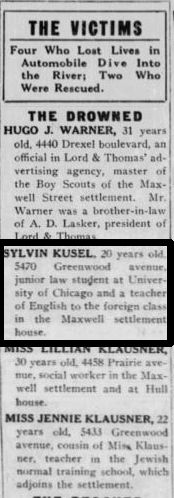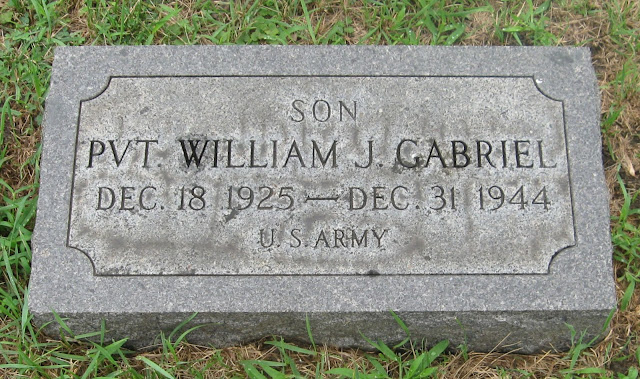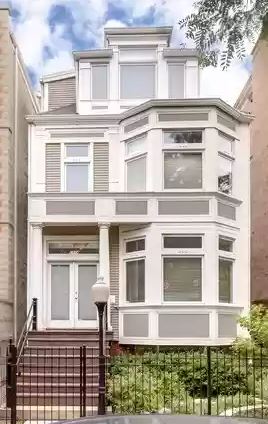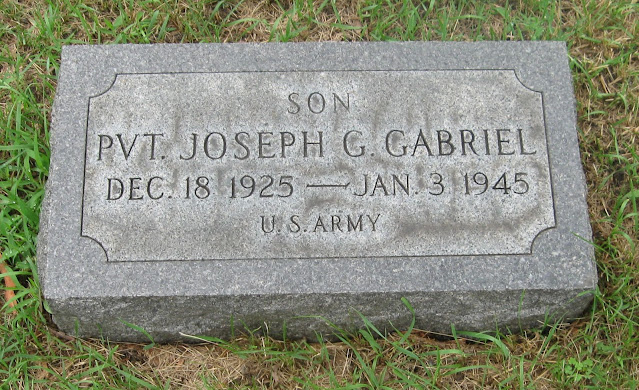I have mentioned in the past that I check ebay on a daily basis for memorabilia from my home town, Evanston, Illinois. I have been quite lucky over the years and have managed to pick up some interesting pieces. Recently I was checking ebay and I saw that someone had listed several old telephone directories for Evanston from the 1940s. I found this on the back cover of one of the 1940s directories:
BTW - the hole in the upper right corner enabled you to hang the directory next to your telephone.
I was very familiar with Marquette Coal and Mining Company - we bought heating oil from them when I was a child. But it was the other advertisement that piqued my curiosity: The Asbury Home - for Convalescents and Elderly People. A lifelong Evanstonian, I had never heard of The Asbury Home, so I figured that it might be an interesting story for this blog, and it is. Before we look at The Asbury Home itself, we need to take a look at the Founder and Manager, Martha (Mrs. Ross) Twitchell.
Martha Elizabeth Johnson was born in Evanston, Illinois on April 30, 1889 to Martin J. Johnson (1854-1920) and Elizabeth "Betsy" Larson Johnson (1856-1915). Martin Johnson was a Clothes Cutter by trade. Martin and Betsy Johnson had nine children: James Garfield Johnson (1882-1938), Anna K. Johnson/Mrs. Frank Hoppe (1884-1960), Oscar Adolph Johnson (1886-1966), Ruth Victoria Johnson/Mrs. Charles Bourke (1887-1968), Martha Elizabeth Johnson/Mrs. Ross Twitchell (1889-1961), Merritt Martin Johnson (1892-1969), Albert Edward Johnson (1893-1961), and Charles William Johnson (1897-1950). There was also a ninth child who died at a young age that I was unable to identify.
Martha makes her first appearance in the 1900 US Census. The family was living at 1723 Ridge in Evanston. A modern condominium building occupies that spot today. The family consisted of Martin Johnson (45 years old), Betsey (43), James G. (18), Annie (15), Oscar (14), Ruth (12), Martha (11), Merrit (8), Albert (6), and Charles (3). In addition there were three "Boarders": Emma Johnson, Freida Johnson, and Freida Tumander. Emma and Freida T. reported their occupation as "Laundress," Freida J. was a "Seamstress." Martin Johnson said he was born in Illinois, was a "Tailor's Cutter," could read and write English and owned the family home. Betsey said she was born in Sweden, and emigrated in 1873. She reported that she had given birth to nine children, and eight of them were alive in 1900.
The 1910 Census showed the Johnsons still living at 1723 Ridge Avenue in Evanston. The family consisted of: Martin J. Johnson (55), Betty (54), James G. (27), Anna (25), Ruth V. Palmer (22), her husband William Palmer (30), Martha Johnson (20), Merritt (18), Albert (16), and Charles (13). Martin Johnson reported his occupation as a "Tailor" in "Manufacturing." James worked in a Stationery Store, Anna was a Telephone Operator, William Palmer was a Clerk in a Hotel, and Merritt worked in "Dairy." No occupation was listed for Martha.
The 1910 US Census for the Johnson Family was reported on April 19, 1910. On August 10, 1910, Martha Johnson married Edward R. Rake. The bride was 18, the groom was 19.
Edward R. Rake (1891-1972) was born September 17, 1891 in Niles Township, Illinois. He was a Steamfitter by trade. The newlyweds moved into 2013 Livingston in Evanston:
 |
| 2013 Livingston, Evanston, Illinois |
Martha and Edward were blessed with two children: Virginia Marguerite Rake (1911-1933) and Marshall Edward Rake (1912-1974).
Before the 1920 US Census Martha had lost both of her parents. Her mother Betsy died September 29, 1915 at the age of fifty-nine and her father Martin died January 15, 1920 at the age of sixty-five.
The 1920 US Census for the Rake Family took place on January 30th and 31st, 1920. The Rake Family was living at 2506 Payne Street in Evanston:
 |
| 2506 Payne Street, Evanston, Illinois |
The family consisted of Edward (28), Martha (30), Virginia (8) and Marshall (7). Edward said he was a "Steamfitter." Martha's father Martin Johnson had been living with them until his death on January 15. Her siblings Anna (34) and Charles (23) were also living with the Rakes.
By 1922 the Rake Family had moved to 1623 Orrington Avenue in Evanston, above a store next to the YMCA:
By 1925 the Rake family had moved again - this time to 2526 Ridgeway Avenue in Evanston. A home built in 1998 sits on that plot today. Edward reported his business as "Hardware."
In 1928 the Rakes moved to 2351 Ridge Avenue in Evanston:
 |
| 2351 Ridge Avenue, Evanston, Illinois |
There were significant changes in the Rake family by the time of the 1930 US Census. The biggest change was that Martha and Edward Rake had divorced. Martha and the children were still living at 2351 Ridge, but Edward was not. Edward went on by himself to open a hardware store at 1240 Chicago Avenue in Evanston.
The 1930 US Census reported that the Rake family now consisted of Martha (40), Virginia (19) and Marshall (17). In addition, there was also a Lodger, Ross Twichell. More on him later.
Martha told the Census Taker that she owned the house on Ridge free and clear and that it was worth $18,000 ($291,770 today). Martha reported no occupation and the young people were in school. Ross Twichell was a Mail Carrier and a Veteran of the World War.
In 1931 Martha Johnson Rake married her Boarder, Ross Twichell. Ross' last name was sometimes spelled "Twichell" and sometimes "Twitchell." The bride was forty-two years old, the groom was thirty-four years old.
On May 1, 1933, Martha's daughter Virginia died. She was twenty-one years old.
She is buried in Memorial Park Cemetery in Skokie, Illinois:
The house that used to sit at 1554 Asbury Avenue (the northwest corner of Asbury and Grove) in Evanston was built in 1894/95. Here is a copy of the application to build a "2 story and Basement + Attic" House:
 |
| 1554 Asbury Avenue, Evanston, Illinois |
In all likelihood it was built as a rooming house or small hotel inasmuch as it had 23 rooms. Although people in those days had large families and live-in servants, it is unlikely that a family would need a 23 room house. The earliest reference I could find to 1554 Asbury was in 1895 when it was called the "Hotel Netherlands." Here is an ad from the Chicago Tribune of December 1, 1895:
The Hotel Netherlands was still operating through 1909 although the owner, a "Mr. Caldwell" attempted to sell the building and furnishings as reported in the Chicago Tribune of January 24, 1904:
In 1910 it changed names again, now being called "The Asbury" run by Mrs. Frances Diefendorf. This is from the Chicago Tribune from August 12, 1914:
Mrs. Diefendorf seemed determined to make The Asbury a world-class hotel, even advertising in the El Paso (TX) Herald in 1914:
1554 Asbury changed ownership in 1922 when it was renamed the "Asbury Apartments" owned by a man named Henry C. Landon.
In 1925 it changed to the "Asbury Inn" run by Catherine Boyd.
In 1929 it was now the "Asbury Hotel," run again by Henry C. Landon. Here is an ad from the Chicago Tribune from June 4, 1933:
It remained the Asbury Hotel until 1935 when the building was bought by Martha Twitchell and opened as the The Asbury Home for Convalescents and Elderly People.
You would not expect a nursing home to generate much publicity and that is the case with the Asbury Home. In fact, the only time it was mentioned in the Chicago newspapers was in connection with an elderly resident who had passed away.
The 1940 US Census has one separate page devoted to the "Asbury Home for Convalescents." Ross Twichell was listed as the head. He said he was forty-three years old, and had completed four years of high school. He had lived in the same place in 1935. He listed his occupation as "Mail Carrier for the Post Office." He reported his income for 1939 as $2,100.00.
Martha Twichell was listed next. She said she was forty-nine years old (she was actually 50). She had also lived in the same place in 1935 and had gone as far as the 7th grade. Strangely she reported no income and no occupation.
Along with the Twichells in the Asbury House was one Registered Nurse, one Practical Nurse, two Maids and fourteen Patients.
The 1950 US Census shows Martha and Ross Twichell living at 1560 Asbury as opposed to the nursing home which is at 1554 Asbury. Ross lists his age as fifty-three; Martha said she was fifty-eight. They both list their occupation as "Co-Owner of Old Womens Home." Living with them are three Practical Nurses. The Nursing Home itself at 1554 Asbury lists one Private Nurse and fifteen "Lodgers." Among the Lodgers are Otto Foss and Julius McDermid. I wonder how they ended up in an "Old Womens Home."
Martha Twitchell died October 19, 1961 in Evanston. She was seventy-two years old. Here is her obituary from the Chicago Tribune of October 21, 1961:
and her Death Notice from the Chicago Tribune from October 22, 1961:
Here is a photo of her grave at Memorial Park Cemetery in Skokie, Illinois:
Her obituary mentions that Martha Twichell owned and operated two nursing homes in Evanston: the Asbury and the Ridgecrest. After Martha's death, the family decided to sell the Asbury and continue to operate just the Ridgecrest. In 1963 the building at 1554 Asbury was purchased by the Board of Pensions of the Methodist Church, which was at that time headquartered in Evanston. They applied for a permit to raze the building and a permit was issued in December of 1963:
In 1964 the Methodist Pension Board built several homes on the property that had been occupied by The Asbury Home. Perhaps they were built to house executives of the Pension Board - I was unable to verify that, but I do know that the houses are no longer owned by the Methodists. Perhaps someone who reads this article will be able to fill me in on the details.
I was never in the Asbury but I do have a personal connection here because my maternal grandmother was a resident of the Ridgecrest from 1965 until her death in February of 1966. The Ridgecrest Nursing and Convalescent Home was in a big old home on the northwest corner of Ridge Avenue and Church Street in Evanston. I was only nine years old when my grandmother moved into the Ridgecrest but I remember it well. My mother's oldest brother, Anthony J. "Tony" Kramer had been an alderman and Justice of the Peace in Evanston for many years. When it came time to look for a nursing home for his mother he did some checking and The Ridgecrest was very highly recommended. There was said to be a long waiting list to get into the Ridgecrest but apparently my Uncle Tony used his political influence and got my grandmother into the home as soon as it was practicable. I remember my mother dealing with a "Mrs. Rake" who would have to have been Marshall Rake's wife Catherine Buether Rake (1914-1987).
 |
Catherine Rake
Photo courtesy of John Rake |
Martha Twichell was dead by this time, so apparently Mrs. Rake stepped in to manage the Ridgecrest on a daily basis.
The Ridgecrest was at 1703 Ridge Avenue in Evanston. It was a mansion like so many in Evanston from that era. The story was that Mrs. Rake had grown up in the big house at 1703 and that when the house became too expensive to keep as a single family home, she turned it into a nursing home and moved into the coach house in the back. Martha and Ross Twichell did live in the Asbury Nursing home for a time, but I could not find any evidence that Catherine Buether Rake ever lived in the big house at 1703 Ridge either before her marriage to Marshall Rake or after.
Martha Twichell and her successor tried to run the Ridgecrest as much like a family home as possible. Residents were encouraged to bring their own furniture or other items to decorate their rooms at the Ridgecrest. Other than a hospital bed in each room, it looked just like any other large residence. There was a large wrap-around porch outside on the first floor in front where my grandmother loved to sit by the hour and "watch the Fords go by" as she used to say. There was an office of the business as well as kitchens on the first floor, then a big winding staircase up to the second floor which was all bedrooms with connecting baths, and finally the third floor where many of the nursing staff lived.
My grandmother didn't know or didn't realize that she was living in a convalescent home (as they used to call them back then.) She thought she was in a hotel and told my mother that it was the nicest hotel she had ever stayed at.
My grandmother died in 1966, and the Ridgecrest was sold to the YWCA in 1969. The charm of the big old home was what led to its demise: It had no elevators, nor any room to install elevators. Multi-story nursing homes without elevators were doomed to fail.
 |
| The Ridgecrest as seen from Church Street |
The house was used for years by the YWCA but sadly was torn down in 2020.
As mentioned earlier, Martha Johnson Rake Twichell's daughter Virginia died in 1933.
Martha's first husband Edward R. Rake died in 1972.
Her second husband Ross Twichell died in 1973.
Martha's son Marshall Rake died in 1974.
Martha's daughter-in-law Catherine Buether Rake died in 1987.
Martha's grandson Marshall Rake, Jr. died in 2000.
Ross, Martha, Virginia, Marshall, Catherine and Marshall, Jr. are buried in a row in Lot 142 of Section C of Memorial Park Cemetery in Skokie, Illinois.
Edward Rake is also buried at Memorial Park, although in a different section.
So now you know the story of the Asbury Home, another bit of history from Evanston's past. May Martha Twichell and everyone associated with her nursing homes rest in peace.

























































